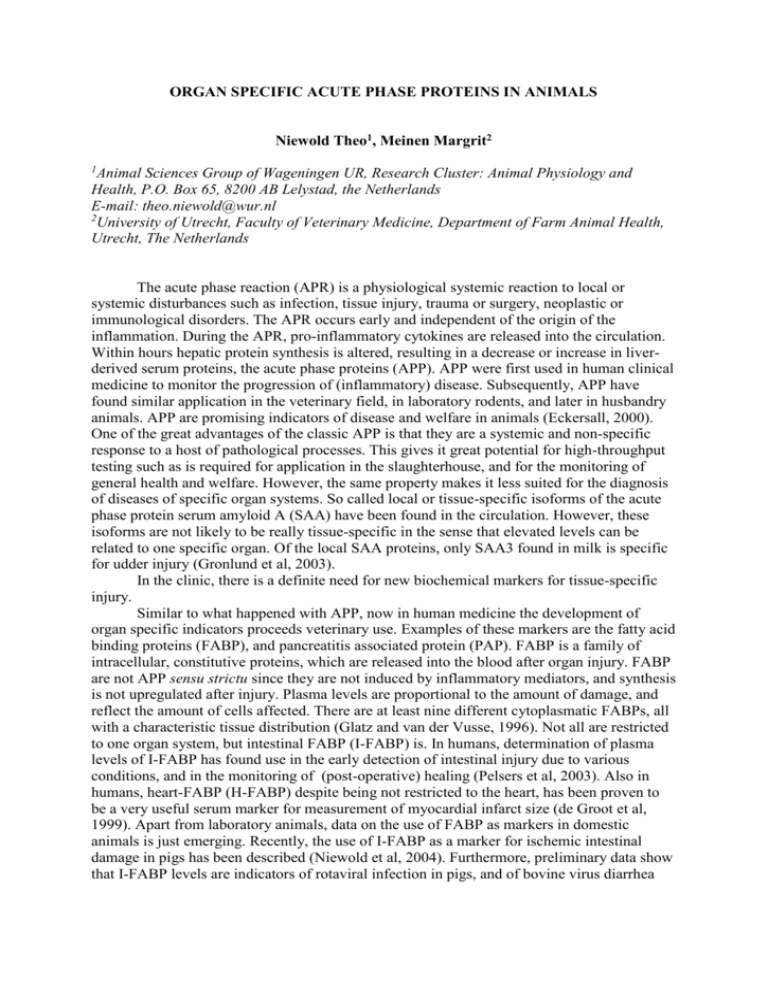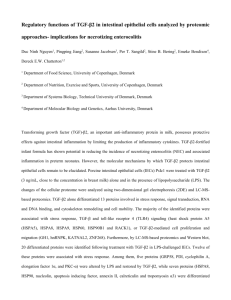Organ specific acute phase proteins in animals
advertisement

ORGAN SPECIFIC ACUTE PHASE PROTEINS IN ANIMALS Niewold Theo1, Meinen Margrit2 1 Animal Sciences Group of Wageningen UR, Research Cluster: Animal Physiology and Health, P.O. Box 65, 8200 AB Lelystad, the Netherlands E-mail: theo.niewold@wur.nl 2 University of Utrecht, Faculty of Veterinary Medicine, Department of Farm Animal Health, Utrecht, The Netherlands The acute phase reaction (APR) is a physiological systemic reaction to local or systemic disturbances such as infection, tissue injury, trauma or surgery, neoplastic or immunological disorders. The APR occurs early and independent of the origin of the inflammation. During the APR, pro-inflammatory cytokines are released into the circulation. Within hours hepatic protein synthesis is altered, resulting in a decrease or increase in liverderived serum proteins, the acute phase proteins (APP). APP were first used in human clinical medicine to monitor the progression of (inflammatory) disease. Subsequently, APP have found similar application in the veterinary field, in laboratory rodents, and later in husbandry animals. APP are promising indicators of disease and welfare in animals (Eckersall, 2000). One of the great advantages of the classic APP is that they are a systemic and non-specific response to a host of pathological processes. This gives it great potential for high-throughput testing such as is required for application in the slaughterhouse, and for the monitoring of general health and welfare. However, the same property makes it less suited for the diagnosis of diseases of specific organ systems. So called local or tissue-specific isoforms of the acute phase protein serum amyloid A (SAA) have been found in the circulation. However, these isoforms are not likely to be really tissue-specific in the sense that elevated levels can be related to one specific organ. Of the local SAA proteins, only SAA3 found in milk is specific for udder injury (Gronlund et al, 2003). In the clinic, there is a definite need for new biochemical markers for tissue-specific injury. Similar to what happened with APP, now in human medicine the development of organ specific indicators proceeds veterinary use. Examples of these markers are the fatty acid binding proteins (FABP), and pancreatitis associated protein (PAP). FABP is a family of intracellular, constitutive proteins, which are released into the blood after organ injury. FABP are not APP sensu strictu since they are not induced by inflammatory mediators, and synthesis is not upregulated after injury. Plasma levels are proportional to the amount of damage, and reflect the amount of cells affected. There are at least nine different cytoplasmatic FABPs, all with a characteristic tissue distribution (Glatz and van der Vusse, 1996). Not all are restricted to one organ system, but intestinal FABP (I-FABP) is. In humans, determination of plasma levels of I-FABP has found use in the early detection of intestinal injury due to various conditions, and in the monitoring of (post-operative) healing (Pelsers et al, 2003). Also in humans, heart-FABP (H-FABP) despite being not restricted to the heart, has been proven to be a very useful serum marker for measurement of myocardial infarct size (de Groot et al, 1999). Apart from laboratory animals, data on the use of FABP as markers in domestic animals is just emerging. Recently, the use of I-FABP as a marker for ischemic intestinal damage in pigs has been described (Niewold et al, 2004). Furthermore, preliminary data show that I-FABP levels are indicators of rotaviral infection in pigs, and of bovine virus diarrhea virus (BVDV) infection in calves. An additional advantage of FABPs is that since they are small proteins (14-15 kDa), detection in urine is also possible. Another example of a tissue-specific marker is PAP. PAP is a C-type lectin, with antiinflammatory properties. PAP was originally described as a marker for pancreatitis (Nordback et al., 1995). In recent years, it became clear that PAP is also produced in the intestine, most likely in Paneth cells. In laboratory rodents, and in humans it was demonstrated that the serum levels of PAP is a good indicator of intestinal inflammatory conditions (Desjeux et al., 2002). There are as yet no data on PAP in domestic animals, but our own preliminary data show PAP to be present in pig small intestine, and that its synthesis is upregulated after infection. In this presentation, we review the clinical use of circulating proteins which are associated with specific organ damage. It is argued that proteins like FABPs and PAP which are already widely used in human medicine should be used similarly in veterinary medicine. Assays for organ and tissue specific damage will find broad application in animal husbandry and for pets. First, it can function as an objective test for the assessment of intestinal health of production animals in different environments and management systems. This could include intensive versus more extensive farming, different feeding regimens etcetera. It will also contribute to health monitoring of farms, and will be used diagnostically by veterinarians. We conclude that organ specific acute phase proteins will be a valuable addition to the classic APP. References Desjeux A., Barthet M., Barthellemy S., Dagorn J.C., Hastier P., Heresbach D., Bernard J.P., Grimaud J.C., 2002. Serum measurements of pancreatitis associated protein in active Crohn's disease with ileal location. Gastroenterol Clin. Biol., 26: 23-28. Eckersall P.D., 2000. Recent advances and future prospects for the use of acute phase proteins as markers of disease in animals. Rev. Med. Vet., 151: 577-584. Glatz J.F.C., van der Vusse G.J., 1996. Cellular fatty acid-binding proteins: their function and physiological significance. Prog. Lipid Res., 35: 243-282. Gronlund U., Hulten C., Eckersall P.D., Hogarth C., Persson Waller K., 2003. Haptoglobin and serum amyloid A in milk and serum during acute and chronic experimentally induced Staphylococcus aureus mastitis. J. Dairy Res., 70: 379-386. de Groot M.J., Wodzig K.W., Simoons M.L., Glatz J.F., Hermens W.T., 1999. Measurement of myocardial infarct size from plasma fatty acid-binding protein or myoglobin, using individually estimated clearance rates. Cardiovasc. Res., 44: 315-324. Kristinsson J., Nygaard K., Sundseth A., Aadland E., Fagerhol M.K., 2002. Comparison of faecal and intestinal concentrations of granulocyte marker protein and localization of gastrointestinal tumours in rats. Scand. J. Gastroenterol., 37: 1029-1033. Niewold T.A., Meinen M., van der Meulen J., 2004. Plasma intestinal fatty acid binding protein (I-FABP) concentrations increase following intestinal ischemia in pigs. Res. Vet. Sci., 77: 89-91. Nordback I., Jaakkola M., Iovanna J.L., Dagorn J.C. 1995. Increased serum pancreatitis associated protein (PAP) concentration after longterm alcohol consumption: further evidence for regular subclinical pancreatic damage after heavy drinking? Gut., 36:117-120. Pelsers M.M., Namiot Z., Kisielewski W., Namiot A., Januszkiewicz M., Hermens W.T., Glatz J.F., 2003. Intestinal-type and liver-type fatty acid-binding protein in the intestine. Tissue distribution and clinical utility. Clin. Biochem., 36: 529-535.







